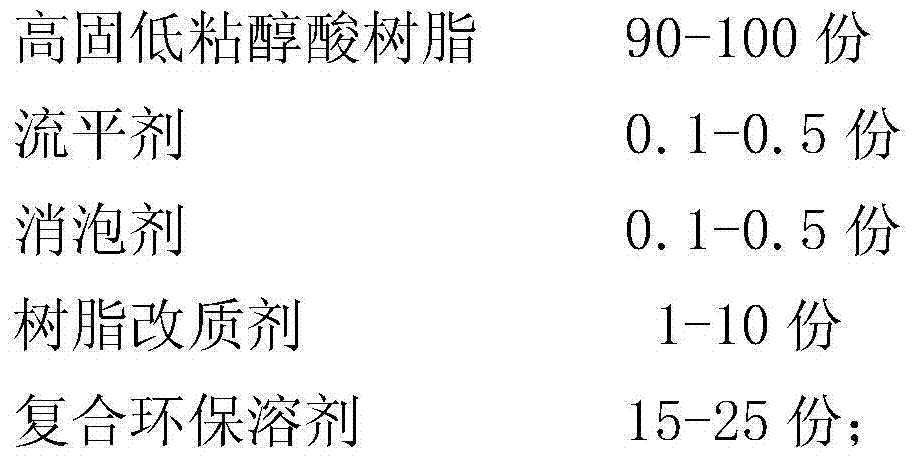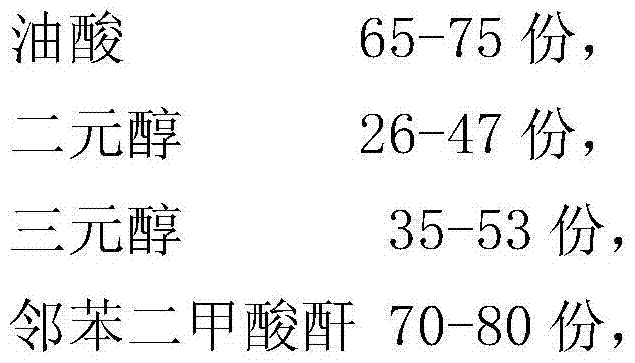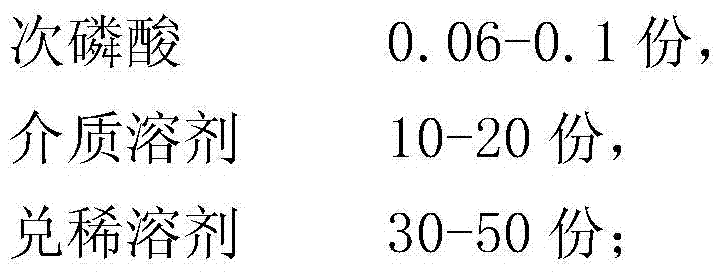Low voc polyurethane gloss varnish
A polyurethane and bright light technology, applied in polyurea/polyurethane coatings, coatings, etc., can solve problems such as poor fullness, easy drying of paint films, and environmental pollution, achieving high solid content in construction, reducing the number of coating layers, The effect of saving raw materials
- Summary
- Abstract
- Description
- Claims
- Application Information
AI Technical Summary
Problems solved by technology
Method used
Image
Examples
specific Embodiment approach
[0032] The specific embodiment of the present invention provides a low-VOC polyurethane gloss varnish, which is characterized in that it is prepared from component A and component B in a weight ratio of 1:0.6-1.
[0033] Component A is made from the following raw materials in weight ratio:
[0034]
[0035] Component B is made from the following raw materials in weight ratio:
[0036] TDI-TMP 50-70 parts,
[0037] HDI trimer 10-30 parts,
[0038] 20-40 parts of butyl acetate.
[0039] The high-solid and low-viscosity alkyd resin is a short-oil alkyd resin produced by our company, and the high-solid and low-viscosity alkyd resin is a high-solid and low-viscosity short-oil alkyd resin, which consists of the following components by weight The ratio of parts is prepared by:
[0040]
[0041] The medium solvent is xylene; the diluted solvent is one of toluene and xylene or any combination of the two. The hydroxyl value of the high-solid low-viscosity alkyd resin is 110-1...
Embodiment 1
[0059] A high-solid, low-viscosity, short-oil alkyd resin, which is prepared from the following components in the following parts by weight:
[0060]
[0061] The preparation method of the above-mentioned high-solid low-viscosity short-oil alkyd resin is prepared according to the following method:
[0062] (1) 70 parts of oleic acid, 26 parts of neopentyl glycol, 53 parts of trimethylolpropane, 80 parts of phthalic anhydride, 0.06 part of hypophosphorous acid, and 15 parts of xylene are put into the reactor;
[0063] (2) Feed nitrogen or carbon dioxide protective gas into the reactor to remove oxygen in the reactor, then heat up to 150°C, after the material is dissolved, stir for 10 minutes at a speed of 300 rpm, then heat up to 165°C, Allow the material to insulate and reflux in the reactor, and perform esterification reaction for 3 hours;
[0064] (3) Slowly heat up to 190° C. for esterification, and take a sample of the resin during the heat preservation esterification pr...
Embodiment 2
[0068] A high-solid, low-viscosity, short-oil alkyd resin, which is prepared from the following components in the following parts by weight:
[0069]
[0070] The preparation method of the above-mentioned high-solid low-viscosity short-oil alkyd resin is characterized in that: it is prepared according to the following method:
[0071] (1) Put 65 parts of oleic acid, 20 parts of diethylene glycol, 16 parts of ethylene glycol, 75 parts of phthalic anhydride, 35 parts of trimethylolpropane, 0.06 parts of hypophosphorous acid, and 10 parts of xylene into the reaction kettle ;
[0072] (2) Feed nitrogen or carbon dioxide protective gas into the reaction kettle to remove the oxygen in the reaction kettle, then heat up to 160°C, after the material is dissolved, stir at a speed of 600 rpm for 20 minutes, then heat up to 180°C, Allow material to insulate and reflux in the reactor, esterify for 4 hours;
[0073] (3) Slowly heat up to 210°C for esterification, and take a sample of t...
PUM
| Property | Measurement | Unit |
|---|---|---|
| hydroxyl value | aaaaa | aaaaa |
| hydroxyl value | aaaaa | aaaaa |
| hydroxyl value | aaaaa | aaaaa |
Abstract
Description
Claims
Application Information
 Login to View More
Login to View More - R&D
- Intellectual Property
- Life Sciences
- Materials
- Tech Scout
- Unparalleled Data Quality
- Higher Quality Content
- 60% Fewer Hallucinations
Browse by: Latest US Patents, China's latest patents, Technical Efficacy Thesaurus, Application Domain, Technology Topic, Popular Technical Reports.
© 2025 PatSnap. All rights reserved.Legal|Privacy policy|Modern Slavery Act Transparency Statement|Sitemap|About US| Contact US: help@patsnap.com



